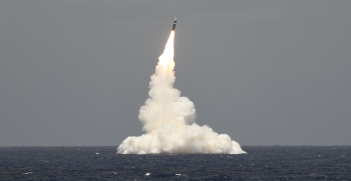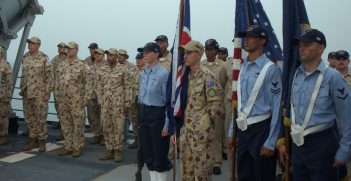A Lonely Fortress? Australia in an Uncertain Future

A curious element of Hugh White’s argument for a massive restructure and rebuilding of Australian defence is that a war with a well-armed enemy could somehow not devastate the trade routes this island nation relies on for supplies.
Hugh White, a former senior defence official, author and academic, has thrown a large rock into Canberra’s pool of strategic assumptions.
In his provocative book, How to Defend Australia, White argues that Australia may no longer be able to rely on the United States if it’s attacked by for instance an increasingly powerful China, and he sets out a radical plan to make this nation much more defendable.
White says Australia must massively reorganise its defence structure by selling off most of its surface ships and replacing those still to be built with a fleet of 24 or even 36 submarines and many more strike aircraft.
He urges a major change of course that would reverse many of the decisions made over the past decade on equipment for the Australian Defence Force and require an increase in defence spending from just under 2 percent of GDP to around 3.5 percent.
White says that in our uncertain future, nothing can be assumed and nations which are friendly now could become threats. But it’s not clear why he feels Australia will end up fighting alone.
He says things have changed and we are less sure now that America will retain any major strategic role in the region: “We have been very fortunate to live under America’s protection for so long and we will sorely miss it when it has gone.”
Containing China’s ambitions in East Asia is going to be expensive and dangerous and, for a range of reasons, the United States will probably not prevail, White says.
“The shift is the direct result of the biggest change in the global distribution of wealth and power in 200 years which has brought to a close the era of Western domination of East Asia which began with Britain’s industrial revolution — and will end with China’s,” he writes.
White offers two scenarios that might trigger conflict. One, if Australia actively supported the United States or Japan in a contest with China for strategic primacy in East Asia or the Western Pacific. The other would be if China achieved military primacy in the region in the absence of a significant US presence. If it used the many levers available to it to keep regional nations divided, then it would be capable of launching a direct attack on Australia.
White is quick to clarify that that doesn’t mean China would have any reason to attack but adds: “We can be sure that if China becomes the leading power in East Asia, and even if its power is exercised prudently and sparingly, the coercive power of its armed forces will always be there behind its diplomacy and soft power as it seeks to influence our decisions and actions. This is how hegemony works.”
He emphasises that he’s not saying China, India, Indonesia or any other Asian country threatens Australia today “but rather that their growing power, the erosion of US leadership, the emergence of more active rivalries, increasing military capabilities and the growing chance of military conflict all increase our strategic risk.”
Many critics have taken White to task over his view that the United States is doomed to decline as China gets stronger. ASPI’s Michael Shoebridge noted that China had its own significant structural problems including a declining birth rate and a seriously aging population. And while the US population is smaller it is, by comparison, much younger.
Some in the capitals of Indonesia, India and Japan may have found it disconcerting that a respected Australian commentator with deep Defence experience, was willing, in a high profile book, to swap them back and forth from “friend” to “potential enemy” columns with little clear explanation of how that would happen.
Indonesia is a case in point. White says that as its wealth and power grows relative to Australia’s, Indonesia will become a more formidable potential adversary. He also says a well-armed Australia could be a more formidable adversary or a more valued ally for Indonesia or another regional power: or with the United States if it did maintain a strategic role.
But if war with Indonesia is even a remote possibility, then Australia needs to employ whatever tools of diplomacy it can find to make that unlikely.
A key strength of the United States is its network of allies, and that can be made to work for Australia too.
China has few allies and, under President Xi, it has become more aggressive domestically and in areas such as the South China Sea. To settle disputes, it has employed a divide and rule strategy by insisting on dealing with nations bilaterally rather than through international courts and other bodies.
Smart support in the right places now may reduce the likelihood of Australia facing an attack alone in the future.
A key argument in White’s book is that Australia needs to shift to a strategy of maritime denial, which would call for a very different navy from the fleet now being built with fewer vulnerable and expensive surface warships and many more submarines.
The current focus on a strong surface fleet aims to control areas of ocean and project power, primarily, he says, in support of the US Navy and that makes no sense. What’s needed is a navy designed to operate independently and to deny the ocean to an attacker confronting Australia by an overriding focus on sinking the adversary’s ships.
White says the purchase of the two giant landing ships, HMAS Canberra and HMAS Adelaide, was a costly mistake compounded by the need to buy a large fleet to protect them. They should be sold and replaced with smaller vessels.
The three air warfare destroyers should be sold and the programs to build nine Hunter-class frigates and 12 offshore patrol vessels abandoned.
In reality, it’s unlikely that any government would be willing to take on such a restructure — more like a massive demolition and rebuilding from scratch — and it would, most likely, be strongly resisted by Defence.
A curious element of White’s argument is that a war with a well-armed enemy could somehow not devastate the trade routes this island nation relies on for supplies. The implication is that we could stockpile what we need to exist and to fight. Australia’s current fuel supplies would last about three weeks.
Former naval officer James Goldrick and analyst Euan Graham used the analogy of a castle that might be well-armed and unassailable but of little use if ran out of water. They observed that “no matter how sophisticated the catapults, it will only be a matter of time before the fortress must fall — and without the need for much action by the besieging force.”
It’s hard to imagine a conflict in which a major adversary would not aim to sink every cargo ship heading to or from Australia that it’s submarines, surface ships and aircraft could find.
Submarines are an effective weapon against other submarines but White argues that shouldn’t be their function. The main targets of his much larger submarine fleet would be an adversary’s surface ships approaching through the archipelago to Australia’s north.
Former foreign minister Gareth Evans says White is initiating a conversation Australia must now have.
That’s true, but the options offered need to be much broader and deeper.
Brendan Nicholson is defence editor of the Australian Strategic Policy Institute commentary site, The Strategist. He has worked for several decades as a journalist and for much of that time he has covered foreign affairs and defence issues on several continents.
This article is published under a Creative Commons Licence and may be republished with attribution.





